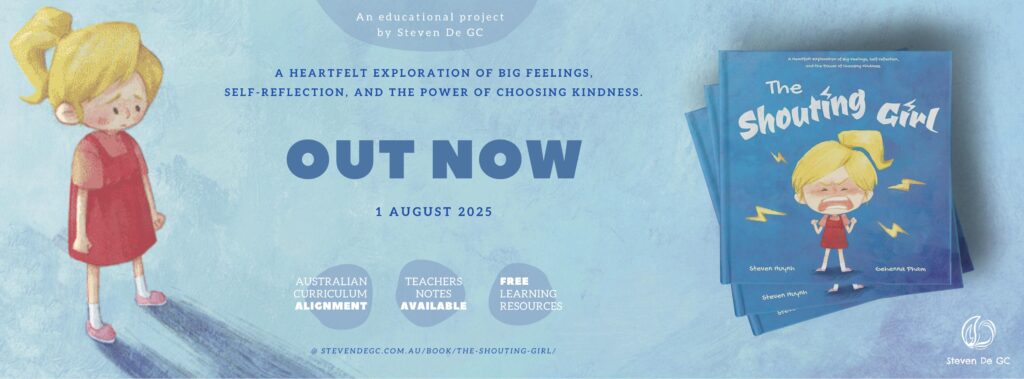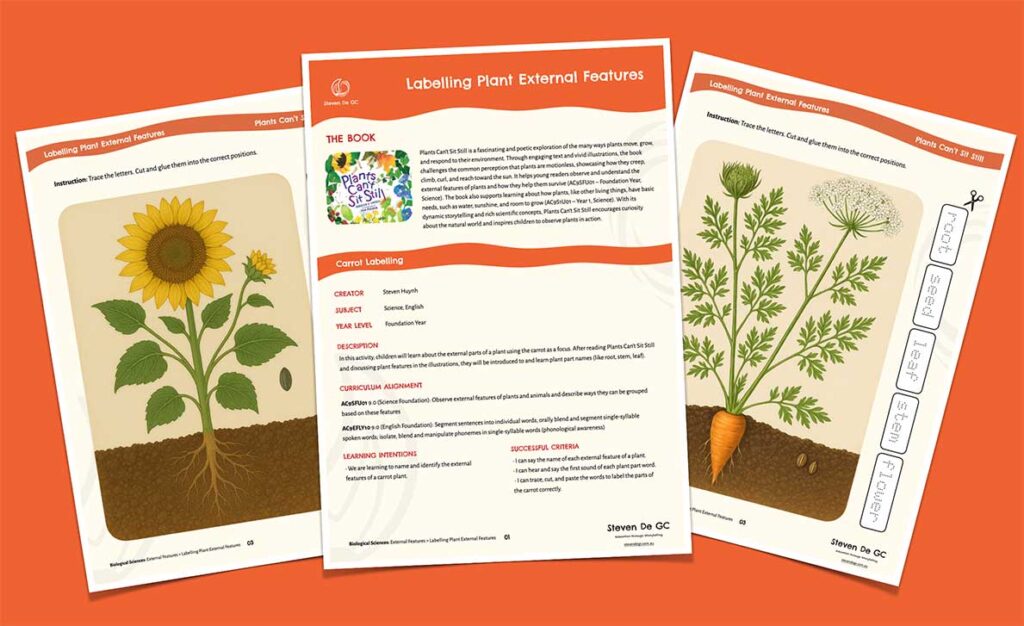- Tuning-in question
- Ask: “How do the main characters’ feelings change from the beginning to the end of the story, and why?”
- Explicitly explain the main idea from the previous lesson: People experience different emotions in different situations.
- Discussion
- Scenario: If you were invited to the narrator’s home for dinner, would you eat with your hands?
- Think about:
- What would you do if you weren’t comfortable?
- How do the characters in the story react?
- What can we learn from them?
- Dialogic Reading (supporting text)
- Read aloud: Bilal Cooks Daal by Aisha Saeed and Anoosha Syed
- Remind students to focus on:
- Characters’ emotions.
- Conversations.
- The dinner table setting and interactions.
- Guide discussion by going through key questions to help students connect ideas from both stories.
- Venn diagram
- Compare the narrator’s friends in Stay for Dinner with Bilal’s friends in Bilal Cooks Daal.
- Identify similarities and differences in their reactions to cultural food.
- Complete a Venn diagram to visualise their responses.
- Big Problem: “Would You Be in Trouble If You Didn’t Eat With Your Hands?”
- Discuss: How might the host feel? What could you say or do to be polite and respectful?
[T4R] Stay For Dinner: L8 Respectful Relationships

The Book
Stay For Dinner
Written by Sandhya Parappukkaran, illustrated by Michelle Pereira, published by Bright Light
Stay for Dinner by Sandhya Parappukkaran is a vibrant celebration of cultural diversity and the connections made through shared meals. The story centres on a family preparing a special dinner for their child’s friends, offering a glimpse into various mealtime customs and table manners (AC9HP2P01 – Years 1 and 2, Health and Physical Education). Through the lens of this dinner, the book explores the emotional responses and questions that arise from cultural traditions (AC9HP2P03 – Years 1 and 2, Health and Physical Education), encouraging children to embrace diversity and appreciate the richness of different cultural backgrounds (AC9HP2P02 – Years 1 and 2, Health and Physical Education).
The narrative is brought to life with vivid sound and imagery words such as “squish,” “splash,” “slice,” and “prong,” capturing the sensory experience of the meal. Culinary terms like “papadum,” “sadhya,” and “dumpling” add authenticity and depth, inviting readers into the world of diverse cuisines. As the main character reflects on her and her friends’ mealtime experiences, the story underscores the importance of understanding and respecting different customs, fostering a sense of togetherness and mutual respect.
With its rich illustrations and heartwarming themes, Stay for Dinner inspires children to find joy in sharing meals and traditions, highlighting the value of friendship and cultural appreciation.
Resource creator
Steven Huynh
Level
Description
This is Lesson 8 of the Talk For Reading (T4R) unit of Stay For Dinner.
This lesson immerses students in a similar cultural context from a different text, allowing them to compare how characters respond to unfamiliar food. Through the lesson, they will reflect on their own choices and learn to build respectful relationships with a host family.
Learning Intentions
• We are learning to make conscious choices to build respectful relationships.
Successful Criteria
• I can identify characters in texts who demonstrate respect for families of different cultures (AC9HP2P02).
• I can make comparisons between the way the main characters react in the text with the friends in Bilal Cooks Daal by by Aisha Saeed (AC9E2LE03).
Curriculum Alignment
AC9E2LE03 9.0 (English Language and Literacy Year 2): Discuss the characters and settings of a range of texts and identify how language is used to present these features in different ways
• comparing how similar characters or settings are described in texts from different contexts; for example, how the seasons are described
• identifying and comparing verb groups used to convey actions, emotions and dialogue in a range of literary texts
• identifying the language used to describe the landscape in First Nations Australians’ stories
AC9HP2P02 9.0 (Health and Physical Education Year 1, Year 2): Identify and explore skills and strategies to develop respectful relationships
• identifying characters in texts who demonstrate respect and cooperation to develop respectful relationships
• identifying characters in texts who demonstrate respect for different types of families and carers, including those of different cultures, abilities or compositions
• demonstrating appropriate language (including verbal, non-verbal, body language and gestures) when encouraging and including others in physical activities, when completing movement tasks or practising for performance
• discussing strategies we can use to show respect to First Nations Australians and acknowledge difference using appropriate language
• describing behaviours that may cause hurt or harm to others, or cause them to feel disrespected, including verbal and physical forms of bullying
Materials
- The book Stay For Dinner
- The book Bilal Cooks Daal by Aisha Saeed and Anoosha Syed
- Post-it notes for Dialogic Reading questions
- a Venn diagram sheet
Instructions
Downloads
| Free Version | Paid Version | |
|---|---|---|
| Material contents | Limited | Full access |
| Instructions | Not included | Included |
| Redownloads | 5 per download | Unlimited |
| Download | FREE DOWNLOAD | BUY WITH |




![[T4R] Stay For Dinner Reading Unit for Year 2 [T4R] Stay For Dinner Reading Unit for Year 2](https://stevendegc.com.au/wp-content/uploads/2025/02/T4R-Stay-For-Dinner-UnitOverviewCover-1024x627.jpg)
![[T4R] Let’s Build a Boat: L11 Evaluation and Reflection [T4R] Let’s Build a Boat: L11 Evaluation and Reflection](https://stevendegc.com.au/wp-content/uploads/2025/05/LetsBuildaBoat-T4R-Lesson11-Cover-1024x626.jpg)
![[T4R] Let’s Build a Boat: L10 Summarising [T4R] Let’s Build a Boat: L10 Summarising](https://stevendegc.com.au/wp-content/uploads/2025/05/LetsBuildaBoat-T4R-Lesson10-Cover-1024x626.jpg)
![[T4R] Let’s Build a Boat: L9 Making Inferences [T4R] Let’s Build a Boat: L9 Making Inferences](https://stevendegc.com.au/wp-content/uploads/2025/05/LetsBuildaBoat-T4R-Lesson9-Cover-1024x625.jpg)
![[T4R] Let’s Build a Boat: L6 Writing a Boat-making Procedure [T4R] Let’s Build a Boat: L6 Writing a Boat-making Procedure](https://stevendegc.com.au/wp-content/uploads/2025/05/LetsBuildaBoat-T4R-Lesson6-Cover-1024x626.jpg)
![[T4R] Let’s Build a Boat: L5 Connecting to a Different Text [T4R] Let’s Build a Boat: L5 Connecting to a Different Text](https://stevendegc.com.au/wp-content/uploads/2025/05/LetsBuildaBoat-T4R-Lesson5-Cover-1024x626.jpg)
![[T4R] Let’s Build a Boat: L4 Literal Retrieval [T4R] Let’s Build a Boat: L4 Literal Retrieval](https://stevendegc.com.au/wp-content/uploads/2025/05/LetsBuildaBoat-T4R-Lesson4-Cover-1024x626.jpg)
![[T4R] Let’s Build a Boat: L3 Making Connections [T4R] Let’s Build a Boat: L3 Making Connections](https://stevendegc.com.au/wp-content/uploads/2025/05/LetsBuildaBoat-T4R-Lesson3-Cover-1024x625.jpg)
![[T4R] Let’s Build a Boat: L2 Making Predictions [T4R] Let’s Build a Boat: L2 Making Predictions](https://stevendegc.com.au/wp-content/uploads/2025/05/LetsBuildaBoat-T4R-L2-Cover-1024x627.jpg)
![[T4R] Let’s Build a Boat: L1 Background Knowledge [T4R] Let’s Build a Boat: L1 Background Knowledge](https://stevendegc.com.au/wp-content/uploads/2025/05/LetsBuildaBoat-T4R-L1-Cover-1024x626.jpg)

Leave a Reply